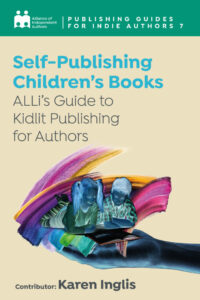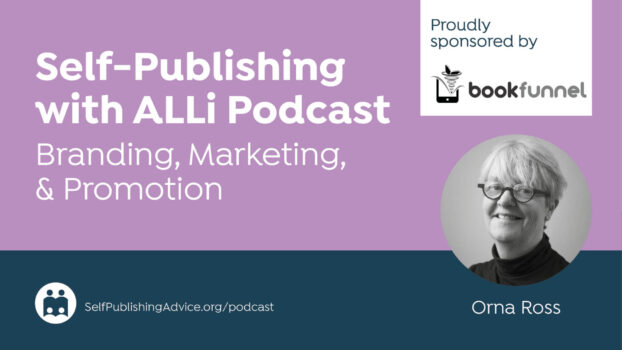
Karen Inglis
Drawing on the expertise of ALLi’s self-publishing children’s authors, and with input from ALLi’s Children’s Advisor, the highly successful children’s author Karen Inglis, this book provides everything you need to know to publish and sell children's books and promote them face-to-face and online.
- How to work with professional children’s editors, illustrators and designers, and how ALLi can help you to find them
- Why in-person events like school visits matter and how to do them successfully
- How tools and tech can help you and make your publishing life productive and profitable
Below is an edited excerpt from our new book.
How Long Does it Take to Self-Publish a Children’s Book?
While writing a children's book may be quicker because there are fewer words, there are still many aspects that take time and patience to complete. Illustrations being one of them.
Good illustrations take time. If you’re working with a good illustrator, there will be a waiting period, and it could be weeks or months before they’re able to get to your project.
Good editing also takes time (yes, even children’s books should be edited!), as does proper formatting and setting up marketing and promotion.
Give yourself a year from concept to completion.
How Much Does It Cost ?
Children's books are generally shorter than books for adults, but that doesn't mean they're cheaper to produce. Illustrations for children's picture books can cost anywhere between $2,000 and $10,000, (though they generally don't exceed $6,000). Each book’s particular circumstances alter the costs incurred in the process: a more polished manuscript, for example, will be less expensive to edit. For that reason, we're a little wary of giving estimates when individual cases differ so much.
That said, however, if we absolutely have to give a ballpark figure for the cost of self-publishing a children's book, we'd say you should expect to spend at least $5,000 and likely more than that for a picture book.
Do I Need a Qualified Illustrator?
Absolutely yes. The success of a children’s book depends on its illustrations. If the illustrations aren’t engaging, it won’t interest young people. A qualified illustrator understands the children’s book publishing industry and knows how to bring your story to life.
For more information on this in particular, make sure to either download for free as an ALLi member or purchase a copy and head to chapter 5, Design.
AskALLi notes: we also have an extensive blog post discussing how to work with illustrators here.
Should I Self-publish Exclusively with Amazon?
One of the most important early decisions you will have to make is whether you keep your e-book exclusive to Amazon by joining their KDP Select Program in exchange for the benefits they provide, or do you “go wide” and publish your book everywhere, including your own website? ALLi recommends the latter.
KDP Select’s biggest selling point is its linked customer-facing program called Kindle Unlimited. Authors’ e-books are made available free to customers who sign up for a Kindle Unlimited account, and you're paid a commission (what Amazon calls a “royalty”) based on the number of page reads your book gets each month. Kindle Unlimited can be lucrative, and many writers of YA and books for adults make a living on their KU income alone. You only get access to this if you sign up for KDP Select and exclusivity. (While you’re in KDP Select, customers who don’t sign up to Kindle Unlimited can still buy your e-book, and you receive the usual royalty on those sales alongside any page-read royalties.)
A further benefit of joining KDP Select is that you get access to promotional extras, such as Countdown Deals or the option to set your e-book free for five days in any 90-day period. If used effectively, both of these can be used to help boost flagging sales, raise the profile of a forgotten backlist title, or get your book off to a great start.
You can’t use these tools unless you go exclusive with Amazon. So why does ALLi recommend “going wide” and avoiding exclusivity, given that KDP Select goes in 90-day terms, meaning it’s not permanent and you can pull your books in and out at any time?
First, we believe the best way to have a sustainable author business is to develop income from many different sources. That way, you’ll be insulated somewhat if one of them dries up. If you rely on Amazon for your income, and Amazon makes a change to KDP Select, you’ve just lost all your income. We’ve seen this happen to too many authors.
The author who chooses exclusivity, whether through a trade-publishing contract or self-publishing through KDP Select or ACX exclusive, cuts off multiple territories and opportunities. While you may have good reasons for making that choice, do not make it without due consideration.
Using KDP Select selectively, rather than having all your books there all the time, can make sense at the start. Being able to set your e-book free for a set number of days each quarter can be invaluable for raising your book’s profile on the largest online retailer in the world. It can also be useful for garnering early reviews for picture books if you’ve created an e-book version. Many picture book authors use this tactic by sharing information about their free days in Facebook groups where parents hang out. As picture books are quick to read, the chances of getting reviews are greater than for books for older children.
If it’s your first book and you need income and reviews to help you get on your feet, it may well be a good idea to go exclusive for a short time. Once your author platform is more established, you’re likely to do yourself more favors long term by being nonexclusive and diversifying your income. Moreover, if you want to get your children’s e-books into libraries or bookstores, you need to be wide, as Amazon doesn’t distribute to libraries at the time of writing and bookstores prefer to get their books from Ingram rather than Amazon.
You will hear indie authors who swear that income from other retailers can’t match what you can make on Amazon, but evidence from ALLi Members indicates that’s not true for all. And while it may be true in the short term for some authors, it’s also true that it takes a long time to build an audience on every retailer, including Amazon, sometimes many years. The longer you wait to go wide, the longer it will take you to build those readerships.
For children’s authors there is a lot to consider, and ultimately only you can decide which route is right for you. What’s definitely not recommended, for anyone, is pulling your book in and out of KDP Select repeatedly, as you destroy any audience you have built up there or on the other platforms.
Use KDP Select at the beginning only if you intend to go wide, or use it to become an Amazon author and stay there if you are comfortable with full reliance on a single platform.
For more, see ALLi’s Ultimate Guide to Publishing Wide: SelfPublishingAdvice.org/publishing-wide/ ALLi Advisor Mark Lefebvre also has a great book on the topic, Wide for the Win.
How Can I Promote My Self-Published Book to Children?
Children’s books are unique, marketing wise, because you don’t actually market to your target audience. Because children aren’t the ones buying books, you market to the people who buy books for children: the adults in their lives.
It gives you a double challenge —to write and publish a book that children will love, and that their parents and relatives will want to buy.
What’s the Single Best Way to Promote a Self-Published Children’s Book?
The school or library visit, in person or online, is very popular. Most schools and libraries welcome visits from authors and most have an annual budget for this. Libraries love hosting story hours with local authors and most libraries have weekly scheduled story times already, with lots of children and parents attending already. Larger libraries even offer multiple story times based on different age groups, making the targeting of your book’s audience even easier.
Get in touch with a local school administrator or librarian. And do take the opportunity to sell some copies of your book. Bring a number of print copies with you on the day of the event, so you can sell your signed book.
Have fun with your visits. Get creative, involve the kids in your reading, let them ask questions, and bring silly props or costumes that relate to your book and that you think the kids might enjoy.
While physical visits are great, don’t neglect digital promotion. Many of ALLi’s most successful children’s authors use carefully targeted social media advertising to reach readers.
For more on this topic, read chapters 8 and 9, marketing and promotion.
Can I Get My Self-Published Children's Book Into Bookstores?
As a self-published author, contrary to popular belief, it’s definitely possible to get your books into bookstores, but it’s challenging and the economics are punishing, especially in the highly competitive children’s book market.
You are likely to have to reach out to bookstores directly and market your books to them in order to get some of that coveted space on their shelves. But it’s not essential to get a book into a physical store any more to get it to readers. When is the last time you purchased a book from a physical bookstore? Self-publishing makes it easy to sell your books to people all around the world through online bookstores and in ebook and audiobook format, as well as print.
If your heart is set on being on a physical shelf, see our guidebook Your Book in Bookstores, by Debbie Young, for more information bout how to do it. Don't forget, ALLi members get free digital download copies of all our books and short guides.
Where Can I Get More Help and Advice?
The Society of Children's Book Writers and Illustrators is the international professional organization for authors and illustrators of books for children and young adults.
“SCBWI is open to anyone with an active interest in children’s literature, from picture books to young adult novels. We welcome aspiring and published writers and illustrators, as well as librarians, educators, translators, artists, students, dramatists, musicians, filmmakers, and others. A passion for children’s literature is the organization’s number one criterion.”
SCBWI also has over 70 regional chapters around the world, allowing you to network with local, like-minded children’s authors. The annual fee is $80, but it’s well worth it — even if you only using a fraction of what they offer. Find out more at SCBWI.com
As well as ALLi and SCBWI, we recommend the Children's Literature Association, childlitassn.org, which takes a more academic approach to children's books, and can give you some great insights.





